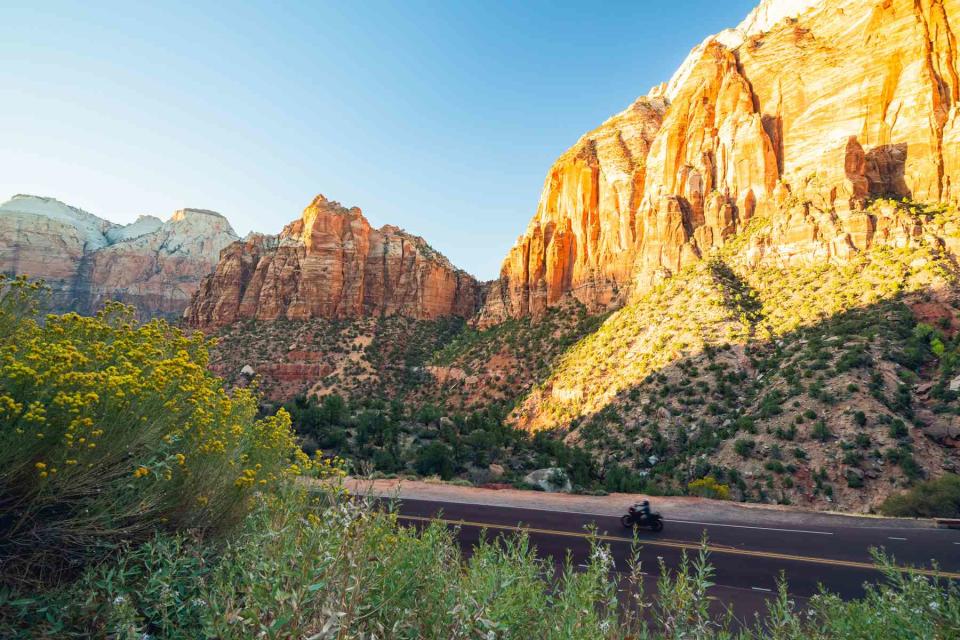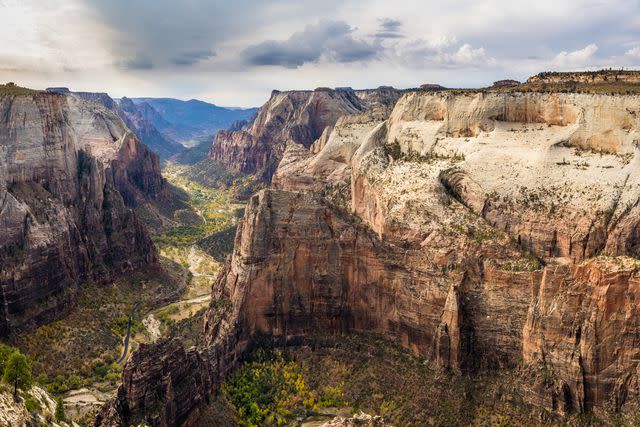The Best Time to Visit Zion National Park
When to visit Zion National Park for the best camping, fewer crowds, sunny weather, and more.

America's national parks offer an abundance of natural wonders and picture-perfect scenes. Perhaps none more than the diverse landscape of Zion National Park.
Utah's first and oldest national park, Zion encompasses 232 square miles of sandstone canyons, soaring cliffs, and coniferous woodlands. With a 5,000-foot elevation change — from Coal Pits Wash at 3,666 feet to Horse Ranch Mountain at 8,726 feet — it's the perfect recreational terrain for rock climbers and hikers alike.
As with any outdoor landscape, there are certain environmental factors to take into consideration when planning a trip, like temperatures and water levels. And, of course, you might consider visiting during the slower seasons to beat the ample crowds that flood into the park each year — Zion saw five million tourists in 2021, making it the 2nd most-visited national park.
From the lowest foot traffic to the most hospitable weather, here are the best and worst times to visit Zion National Park for anyone's itinerary.

The Best Time to Visit Zion National Park for Avoiding the Crowds
Zion National Park is open year-round, but a whopping 70% of visitors come between April and September. If you have the flexibility, planning a trip during the park's off-peak months of October through March will ensure you have to deal with fewer view-blocking selfie sticks and crowded hiking trails.
If you're really looking for a quiet escape, January is the best time to avoid the crowds. The park, which sees over 500,000 visitors during the July peak, historically only gets around 90,000 people in this quiet winter month. And while it may be the middle of winter, the daily temperatures often reach a surprisingly warm 54 degrees — the perfect weather for exploring the trails with a light jacket.
The Best Time to Visit Zion National Park for Hiking the Narrows
The Narrows is easily one of the park's most popular hikes, and for good reason — this truly narrow section of Zion Canyon has thousand-foot-tall walls split by a coursing river. You can get a sense of the area by walking along the paved and wheelchair-accessible Riverside Walk, but for a true Narrows experience, you'll want to throw on a pair of waterproof shoes (or shoes you don't mind getting wet) and walk up the Virgin River, which takes you further into the canyon.
Because you'll be walking up the river, the Narrows is often closed during the spring, when snowmelt causes the river to rise dramatically. And in late fall and winter, the water can be cold. Because of this, people tend to hike the Narrows in summer and early fall, when the water is warmer and at its lowest level, though be mindful of flash flooding — which has led to fatal accidents in the past — regardless of the season.
The Best Time to Visit Zion National Park for Canyoneering
Due to its narrow canyons and numerous waterways, Zion National Park has become one of the country's premier canyoneering destinations — an activity that requires scrambling, climbing, and swimming up, down, and through canyons, often with the aid of ropes.
Beginners can book a tour into the lower end of the Narrows, while more experienced visitors should head to the Subway or Orderville Canyon. You can go canyoneering in Zion year-round, but certain routes will be limited. The most comfortable time to try out the activity is during the summer when the river levels are manageable and the water is warm. Keep in mind that canyoneering permits have to be reserved online up to two months in advance.
The Best Time to Visit Zion National Park for Camping
There's nothing like waking up in the beauty of Zion National Park, which is likely why camping is one of the park's most popular activities. That being said, you'll want to make reservations early, since Zion has just three accessible campgrounds — South, Watchman, and Lava Point — and they fill up fast.
Typically, Watchman Campground, in Zion Canyon, is open year-round, and South is only closed in winter. Lava Point Campground, the more primitive camping option off Kolob Terrace Road, is open May through September. As long as you have appropriate camping gear (or a camper or RV), you can come anytime during that window, although those who want to avoid the heat might want to skip July.
If you’re looking for more remote camping options, you can hike the park’s wilderness trails to reach its designated backpacking sites. The 14-mile La Verkin Creek Trail, popular in spring, summer, and fall, travels along the creek bed toward Kolob Arch, one of the world's largest free-standing arches, and brings you by 10-13 campsites. Be mindful that because these are wilderness areas, they are often affected by wildfires, rockfalls, flash floods, and other natural forces, so be sure to always check the current conditions before heading out.
The Best Time to Visit Zion National Park for Hiking Angels Landing
There's a reason why hiking Angels Landing is a popular once-in-a-lifetime experience for those brave enough to tackle it. Not for the novice hiker, the last part of the trail is cut into solid rock and leads hikers up a narrow, 1,488-foot-tall rock formation known as Angels Landing. The nearly five-and-a-half-mile round-trip hike can be done year-round, but should only be attempted in fair weather because it is quite dangerous. Most people tackle this hike in the summer months, but you'll want to be mindful of the weather — thunderstorms and extreme heat are common, especially in July and August. Also remember that visitors must reserve a permit to hike this trail.
The Best Time to Visit Zion National Park for Driving the Zion Canyon Scenic Drive
If all you want is to check out the renowned Zion Canyon Scenic Drive and hop in and out of the car at your own leisure, you'll want to visit the park before the holidays in December, or in January and February — the only time private vehicles are allowed on the Zion Canyon Scenic Drive.
During the rest of the year, you can still see the sights, but you'll just have to do it from one of the park shuttles, which run daily from spring to late November, before picking up again for the winter holidays in mid-December.
The Best Months to Visit Zion National Park for Good Weather
Due to its unique climate and elevation changes, Zion National Park has a wide range of weather conditions throughout the year that can affect your access to certain trails, sites, and attractions. A good rule of thumb is to check Zion's current conditions no matter the season.
July is the hottest time to visit (daily temperatures can reach an average high of 100 degrees), while January tends to be the coldest month. Thunderstorms are more common in July and August, and the winter months see the most precipitation, including snow, which can effect trail conditions and lead to closures due to flooding and safety.
For park accessibility, summer is hard to beat — Zion's operating hours are longer and the park is typically fully open and accessible. But this is also when you'll see crowds; July is historically the busiest month at Zion. For access to most — if not all — of the park without the summer crowds, visiting during the fall months (October and early November) may be your best bet. The temperature can fluctuate as the weather shifts toward winter, but the fall colors can be stunning and there's nothing an extra layer won't fix.
The Best Time to Visit Zion National Park for Good Prices
No matter when you visit, you'll have to purchase a recreational use pass upon entering Zion. There are options for seven-day weekly passes ($20 per person / $35 per private vehicle) and annual passes ($70). Discounts on the annual passes are available for active duty military (free) and seniors ($20) — seniors also qualify for an $80 lifetime pass. Anyone 15 and under gets in for free year-round. You might consider visiting Zion in the quieter months, particularly sometime between January and March, for better rates and deals from nearby accommodations.
The Worst Time to Visit Zion National Park
If you want to avoid the crowds, skip a trip in June or July, which both see over 500,000 monthly visitors. On the other end of the spectrum, you'll find solitude during the winter months but might also experience below-freezing nights, snow, and limited park access.

